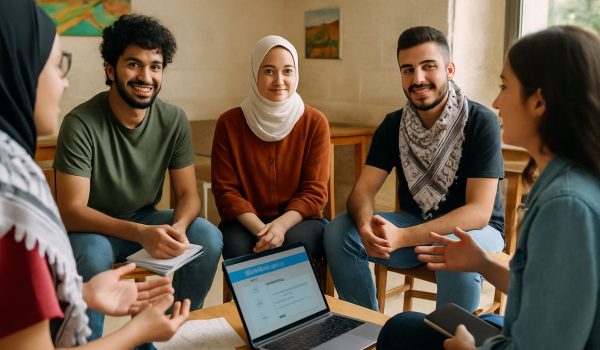In many communities, stories help people feel seen and understood. For Palestinian youth, storytelling circles have become more than a way to share—they’re a source of strength, pride, and connection. These circles offer a space to talk, listen, and reflect. In a world that often silences them, young people are finding their voices through shared stories.
Story circles bring young people together in an honest and supportive way. There are no wrong answers, no perfect words. Just a chance to speak from the heart and be heard. This simple practice is helping young Palestinians process trauma, build leadership skills, and imagine futures filled with possibility.
What This Article Covers
This post explains how story circles are helping Palestinian youth grow, cope, and lead. It highlights:
- The structure and purpose of story circles
- How storytelling builds confidence and connection
- Ways these circles support healing, identity, and action
The Heart of a Story Circle
A story circle is not a lecture or a debate. It’s a safe, respectful space where each person is invited to share a personal story. No one is forced to speak, and everyone listens without interrupting. The goal isn’t to give advice or correct someone—it’s simply to listen and learn.
These circles are often led by a peer or trained facilitator. They might start with a simple prompt like, “Talk about a time you felt proud” or “Tell us about something you wish others understood.” From there, each voice adds something meaningful to the group.
In refugee camps, youth centers, or living rooms, story circles are becoming a powerful tool for connection. They help young people break through isolation and realize they’re not alone in their struggles or their dreams.
Finding Confidence Through Voice
For many Palestinian youth, life comes with constant challenges. Checkpoints, limited resources, and political tension can weigh heavily on their day-to-day experiences. Storytelling helps lift that weight, even for a little while. It gives them a moment to own their story instead of letting others define it.
Speaking in a group builds confidence. It teaches young people that their words matter. For some, it’s the first time they’ve felt truly heard. For others, it’s a step toward leadership. They begin to see themselves as more than victims—they are thinkers, creators, and changemakers.
In these circles, shy teens grow bold. Listeners become speakers. And speakers often go on to support others in finding their voice, too.
Storytelling as a Path to Healing
Pain is part of many stories shared in these circles. Loss, displacement, fear—these are common themes. But when shared in community, these stories begin to feel less heavy. Hearing someone else speak openly makes it easier to speak your own truth.
The act of telling a personal story can be healing. It allows someone to name their experience and feel supported. It also helps others in the group realize they’re not alone. This shared understanding builds trust, and that trust becomes the foundation for emotional support and resilience.
In many cases, story circles are paired with mental health programs or leadership workshops. This gives participants tools to process their emotions and channel their energy into positive action.
Strengthening Identity and Culture
Storytelling isn’t just about healing—it’s also about remembering. Many young Palestinians haven’t seen the homes their grandparents talk about or the olive groves they once walked through. But through stories, they come to know these places and the history they carry.
Story circles are helping youth reconnect with their roots. They hear stories of resistance, family strength, and community care. These stories build pride and a deeper sense of identity. They remind participants that they come from a people with deep history, dignity, and hope.
When youth learn to tell their own stories, they also learn to challenge the way others tell stories about them. They no longer accept being spoken for. Instead, they speak for themselves—with honesty and courage.
Creating New Leaders
One of the lasting effects of story circles is the leadership they inspire. Youth who join these circles often begin taking active roles in their communities. They lead discussions, organize events, or help others share their stories through art, film, or writing.
These young leaders bring a different kind of strength. They are not just leading with facts—they’re leading with heart. They know how to listen, how to include others, and how to build community around shared values.
Programs that support storytelling often see ripple effects. A small group of storytellers becomes a network of active citizens. The impact spreads from the circle to schools, homes, and local organizations.
A Tool for Action and Change
Telling stories is not just about the past. It’s also about the future. In story circles, youth often imagine the world they want to live in. They talk about dreams for their communities, their families, and themselves.
This kind of storytelling turns into action. Some groups write public letters. Others create podcasts or community theater. The power of the story doesn’t stay in the room—it moves out into the world and makes a difference.
When young Palestinians tell their stories, they challenge stereotypes and spark conversation. They help others understand the complexity of their lives. They remind the world that they are not defined by borders or headlines, but by their voices and values.
Story circles are more than a place to talk. They are spaces for growth, healing, and hope. Through listening and sharing, Palestinian youth are building stronger communities, deeper identities, and brighter futures—one story at a time.

